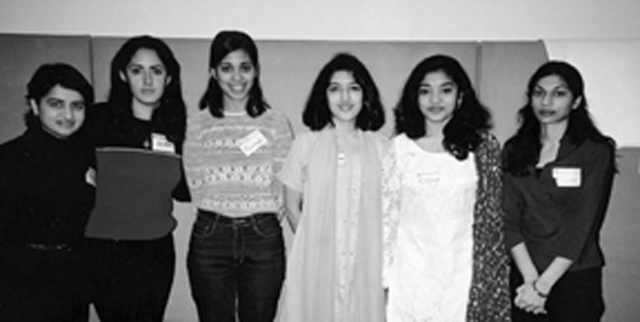INTERFAITH ENCOUNTER
A Young Person’s Account
By Farrah Miranda
September 2001
Return to Table of Contents
Print Article
Earlier this year, Scarboro Missions teamed up with the Toronto Baha’i community to sponsor an interfaith event at the Baha’i Center. The program, titled “Serving Humanity”, attracted a multifaith audience of 300 people, almost half of them teenagers. The following account was written by Farrah Miranda who spoke at the event. At the time, Farrah was a student at Iona Catholic Secondary School in Oakville, Ontario. She now attends the University of Toronto, studying international development.
This past February, I had the pleasure of attending the Interfaith Day hosted by the Baha’i Centre. Members of all faiths were called to embrace each other and to discuss the basic teaching of all religions: the obligation to love and to serve.
 Multifaith youth panel at Toronto Baha’i Centre. L-R: Mona Kothari (Jain) Gloria Arjomand (Baha’i), Farrah Miranda (Christian) Lakshmi Viswanathan (Hindu), Rasagnya Rao (Hindu), Manpreet Jaswal
(Sikh).
Multifaith youth panel at Toronto Baha’i Centre. L-R: Mona Kothari (Jain) Gloria Arjomand (Baha’i), Farrah Miranda (Christian) Lakshmi Viswanathan (Hindu), Rasagnya Rao (Hindu), Manpreet Jaswal
(Sikh).
The audience consisted of young people and adults, all eager to discuss the theme of serving humanity. Although the day was organized largely by adults, the main focus was youth and their call to serve.
I was invited to be part of a multifaith youth panel. This responsibility left me excited but nervous. As I neared the Baha’i Centre that afternoon, I was not at all sure of what to expect. My uncertainties soon diminished, however, as I entered the building and was greeted by the gracious members of the Baha’i community.
The program began with beautiful prayers, songs and scriptures which members of the Baha’i community shared with us. Other members of the community introduced us to the basics of their Baha’i religion which stresses the importance of love and respect for humanity.
Baha’u’llah, the founder of the Baha’i faith, taught that all peoples in the world belong to a single family. Baha’is believe that God wants us to break down the barriers that divide us as humans. God wills that we strive to create a world where all people can live equally as brothers and sisters, regardless of race, sex, nation or religion.
I find this Baha’i attitude of openness to and acceptance of others to be very inspiring. One of the Baha’i speakers put it perfectly when she suggested that “the world’s religions are all different chapters of the same book.” I believe that each religion calls us to love and honour the same God by doing God’s work. This involves offering our love and service to others.
To provide a more personal insight into the theme of service and religion, youth from a number of religions were asked to speak. As a Christian, I spoke about Jesus Christ and His example of compassion for others, how His life inspires me to offer what help I can to those in need.
Following my presentation, we heard from five other young women, all of whom served as witnesses to their faith through action. This group of women included two Hindus, a Jain, a Sikh and a Baha’i.
Their calls to service varied. Some felt that it was their duty to serve their family and local community, while others felt compelled to serve the poor overseas. And though each engaged in a different kind of service, they all had one thing in common—everything was done out of love and compassion.
I think that I speak for all the young people who attended the day when I say that we were extremely grateful to have been given a voice. In a society where youth are often portrayed with negative stereotypes, I commend those who have not lost faith in the younger generation.
After a delicious lunch prepared by the Baha’i community, people organized themselves into discussion groups, each focusing on a specific issue related to service. My group wrestled with the social and environmental impact of free trade, and posed possible solutions. Other groups discussed issues such as peer pressure, media and homelessness.
After nearly an hour of intense group discussion, everyone gathered for a plenary. Here each group had an opportunity to summarize its discussion and share solutions. I loved the idea of breaking down into more intimate groups and then sharing learnings with the larger audience—this was an excellent way to increase social awareness.
Just when I thought the day could not get any better, we were treated to a spectacular performance by the Wildfire Dance Troop. The dancers expressed artistically the very issues we were discussing during the day, arousing our emotions and captivating our interest. The themes of their dances ranged from racism to poverty to addiction. Indeed, they seemed to touch on all the major issues.
For me, the most overwhelming aspect of their performance occurred when the dancers introduced themselves. We learned that they came from different parts of the world, including Africa, the Middle East, Europe, Australia, and North and South America.
All the dancers were Baha’is and all were young people. They had come together to creatively express the basics of their religion. These dancers taught me that service can be expressed in many different forms. It’s all about using God’s gifts to do God’s work.
“All who are concerned with the education of youth are certainly conscious of the need of educating for dialogue. In accompanying young people along the highways of life, attention has to be given to the preparation required for living in a society marked by ethnic, cultural and religious plurality...”
Cardinal Francis Arinze
Pontifical Council for Interreligious Dialogue
From a Vatican greeting directed to the international Muslim community (2001)
Return to Table of Contents
Print Article